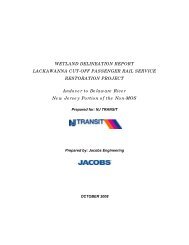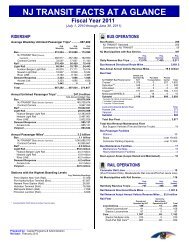APPENDIX L: Endangered Species Technical Report - New Jersey ...
APPENDIX L: Endangered Species Technical Report - New Jersey ...
APPENDIX L: Endangered Species Technical Report - New Jersey ...
You also want an ePaper? Increase the reach of your titles
YUMPU automatically turns print PDFs into web optimized ePapers that Google loves.
<strong>New</strong> <strong>Jersey</strong> – Pennsylvania Lackawanna Cut-Off Passenger Rail Service Restoration Project Environmental Assessment FINAL<br />
Indiana Bat<br />
USFWS is concerned with the destruction of forest habitat resulting from the project that may further<br />
endanger the Indiana bat, a federally endangered species listed under the ESA. The USFWS reports that<br />
the Indiana bat is known to roost in only three hibernaculums located in Morris County, <strong>New</strong> <strong>Jersey</strong>.<br />
While two of these hibernaculums are located greater than five miles from where the study corridor<br />
begins in Port Morris, NJ, the summer range of the bat extends far beyond these hibernaculums and<br />
throughout the northern forested portions of the state.<br />
The Indiana bat is a medium sized bat that closely resembles the Brown bat however most notably differs<br />
from the Brown bat by its grayish fur. Indiana bat Hibernalculums are found in limestone caves as well<br />
as abandoned mine shafts such as those in Morris County. In the summer months these bats roost in<br />
various forest habitats underneath loose tree bark or in cavities of dead trees/snags during the day. At<br />
night the bats forage for insects in and around the tree canopy of the forest. Threats to the Indian bats’<br />
survival include disturbance or killing of hibernating and maternity colonies through forest fragmentation,<br />
degradation and destruction of forested summer habitat, by vandals entering caves and abandoned mine<br />
shafts, improper gating of caves and mine shafts, and the use of pesticides and other environmental<br />
contaminants.<br />
The USFWS has requested that the study corridor be examined for the presence of suitable forest habitat.<br />
A lack of existing data prevents them from determining whether the project will pose an adverse impact<br />
to the bat.<br />
Bald Eagle<br />
On July 6, 1999 the USFWS proposed to have the Bald eagle removed from the federal List of<br />
<strong>Endangered</strong> and Threatened Wildlife, (Federal Registar, Vol. 64, No. 128), however final action on this<br />
proposal has yet to occur. The Bald eagle therefore continues its status as a federally endangered species<br />
under the jurisdiction of the USFWS.<br />
Bald eagles prefer to live and forage in and around the vicinity of lakes, reservoirs, wetlands and large<br />
river systems like that of the Delaware River that support healthy populations of large fishes. They<br />
construct their nests in supper canopy trees of the forests surrounding these aquatic resources. A supper<br />
canopy tree is that of which extends above the overall forest canopy providing both shelter for the nest<br />
and excellent perches for fishing. The USFWS requests that a mid-winter aerial survey for the presence<br />
of bald eagle nests be conducted by a qualified wildlife biologist along the Pennsylvania portion of the<br />
study corridor.<br />
The Bald eagle was first listed as an endangered species under the <strong>Endangered</strong> <strong>Species</strong> Act in 1978 when<br />
it was experiencing drastic population declines resulting from the bioaccumulation of DDT in its food<br />
supply. Consumption of fish, which often contained high-levels of DDT caused the shells of bald eagle<br />
eggs to weaken and crack under the weight of the mother during incubation. Destruction of habitat, and<br />
poaching also contributed to the decline or our nation’s icon long before the introduction of DDT in the<br />
1940’s. Through the implementation of the ESA and other wildlife conservation initiatives and the<br />
banning of DDT the bald eagle has made a substantial recovery. Today its population continues to<br />
steadily increase.<br />
NJ TRANSIT June 2008<br />
L-3
















